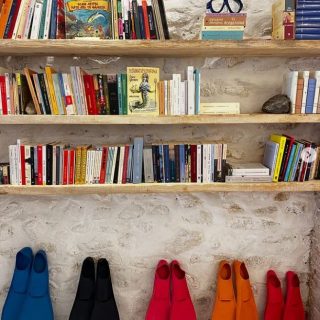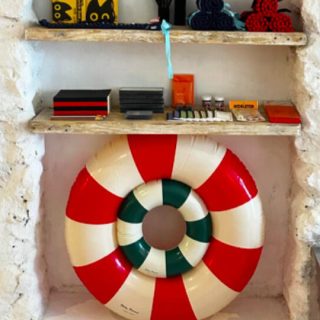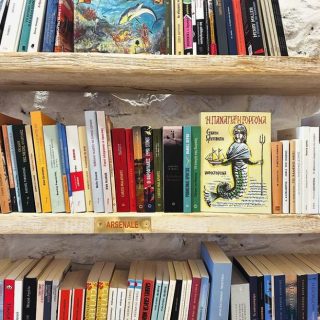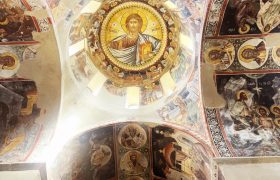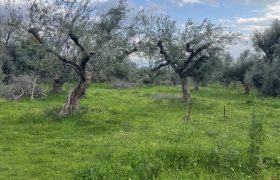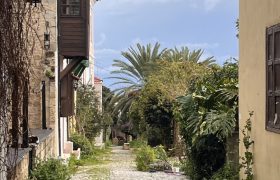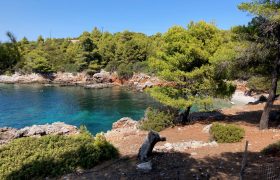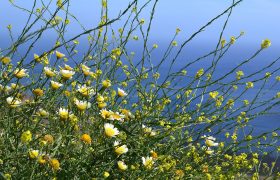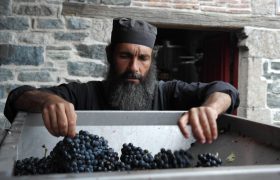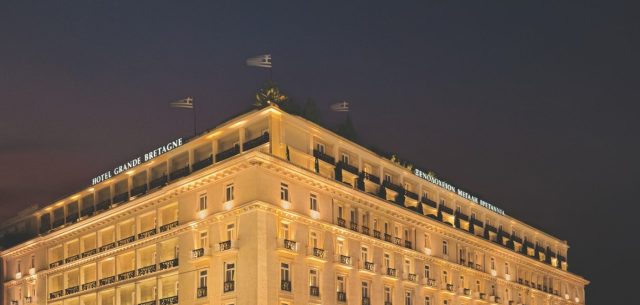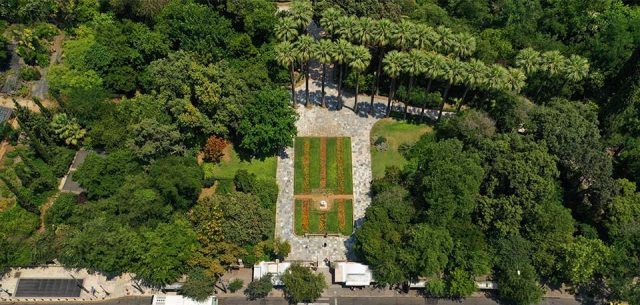A Brief Stay in Anafi
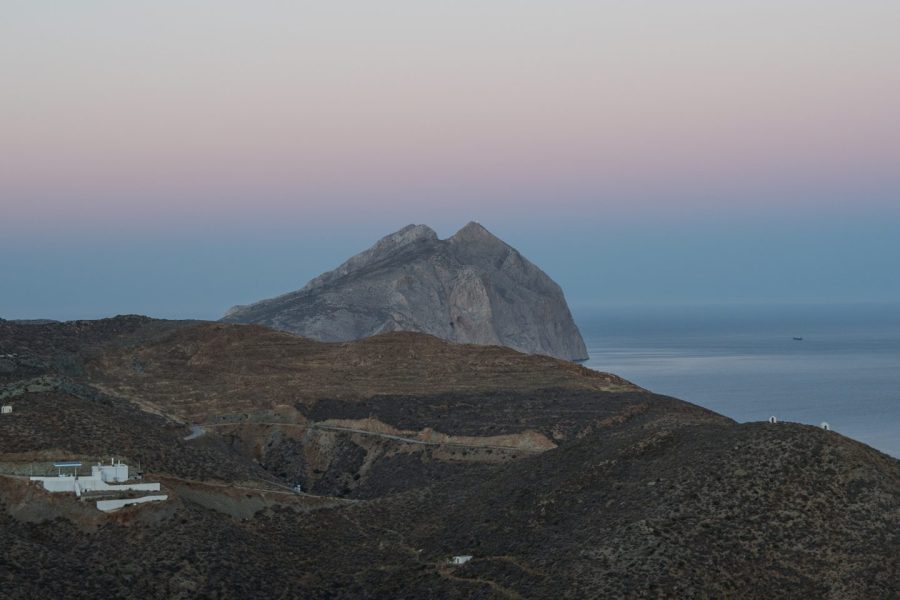
Anafi is one of the Greek islands that almost functions like a secret code word. Utter its name and the cool kids, of all ages, get a knowing yet faraway look in their eye. Tom Hall had wanted to visit since moving to Athens in 2020 and finally got the chance in the summer of 2024. Here’s an account of his brief first stay which will definitely not be his last.
Anafi first entered my consciousness through its Plaka outpost, Anafiotika. This perfect Cycladic village in miniature, clinging to the skirts of the Acropolis, was to establish in my mind a transporting sense of magic and otherworldliness which I now know is very much in keeping with the island itself. Anafiotika was built by craftsmen who had been transplanted from the island to support the rapid expansion up and out of Athens from the 30s onwards. The first two inhabitants were a carpenter and a construction worker, and stone masons and marble workers were to follow. That short anecdote contains within it some of the themes that permeate Anafi like veins in rock. Not only the craftsmanship which is on evidence all over the island, but also the sense of transportation, the ebb and flow of talent and tourism, the need to leave and the need to return. Apart from my fascination with Anafiotika, my fiance is a long term visitor to, and occasional resident on, the island which is an important part of her Greek story and I was excited to see it through her eyes as well as experience it for myself. The main ferry from Athens arrives around 5 am, which means that when you sleepwalk onto the pier you are already primed for a surreal, dreamlike, encounter. The name Anafi derives from ancient Greek words meaning to “reveal” and “shine a light”. It originates from the story of Apollo revealing, or perhaps creating, the island as a safe habour for the storm-struck Argonauts, so good pedigree in mythological terms. The island has been a sanctuary and playground for waves of marginalised groups ever since, from people fleeing war, to political dissidents and then later the artistic and LGQBT+ communities seeking safe places to gather, relax and create. As we disembarked onto the port with the peachy sky presaging Apollo’s shining light, leading the way, I could immediately see why people fall in love with the island. What follows is a brief account of where we stayed and what we ate, drank and saw for the short week we were there.
What we ate and drank
I must confess that I was subject to an assumption bordering on prejudice with regards to food and drink on the island. Knowing that I am a card carrying glutton, friends had warned me that the food on the island was rustic and there wasn’t a lot of variation. I’ve been to regional France enough times to know that rustic variations on a theme can mean very good things indeed. I’m thinking in particular of a trip to Carcassone on which I must have had Cassoulet eight times in ten days and could have had more. For some reason on this occasion I managed to autocorrect the warnings so that I wasn’t excited about the food and was preparing a brave face. How wrong I was as nearly every meal I ate on the island was delicious and memorable. It’s a small island so it’s true that there aren’t a lot of options but that is a pleasure in its own right. We all know the paralysing agony of an overabundance of choice, so the opposite was strangely soothing. My pick below. I’ve ordered them by the amount of visits.
Margarita’s Restaurant and Rooms at Klisidi Beach.
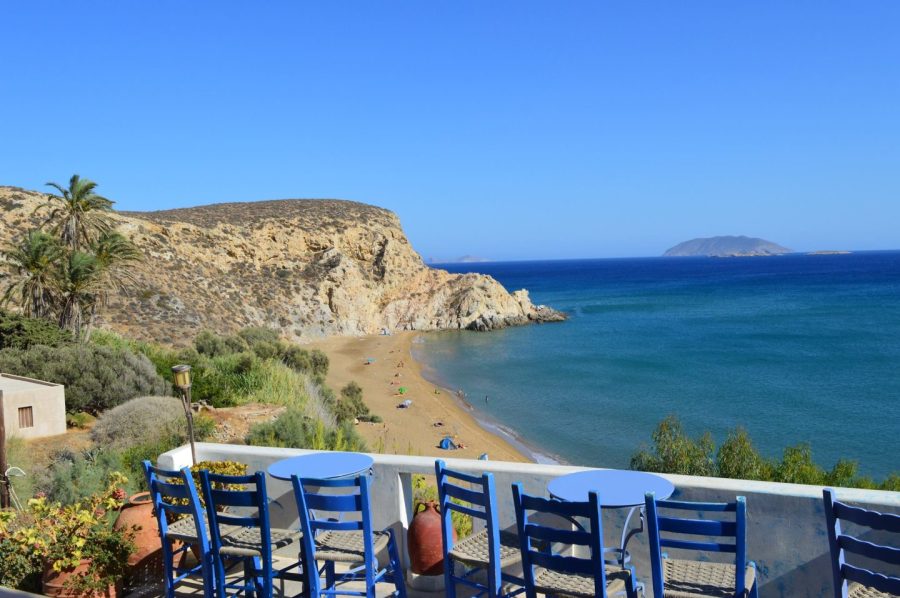
This was the first place that we ate outside of the hotel and we went back four times in the short week we were there. Established by the eponymous Margarita who is still around watering plants and petting cats, Margarita’s is now run by her daughter Effie who would be a contender for nicest person on the island (and being Anafi that would be a stiff competition). Set back on a steep slope behind the beach, the restaurant feels like it has evolved organically over the years which makes it a comfortable and easy place to lose hours. The menu, which seems also to evolve daily, is excellent. Their new chef this year has already found his feet and is producing balanced and nuanced food with a particularly confident touch on the grill. We had string beans that were charred black in places and delicious for it. These were served with cooked peaches and an aioli and we ordered this dish whenever it was on the menu. The steamed grouper was another hit, as was the Anafi salad. Delicious food in a soothing environment that feels like it’s doing you good.
Ktima Roukouna
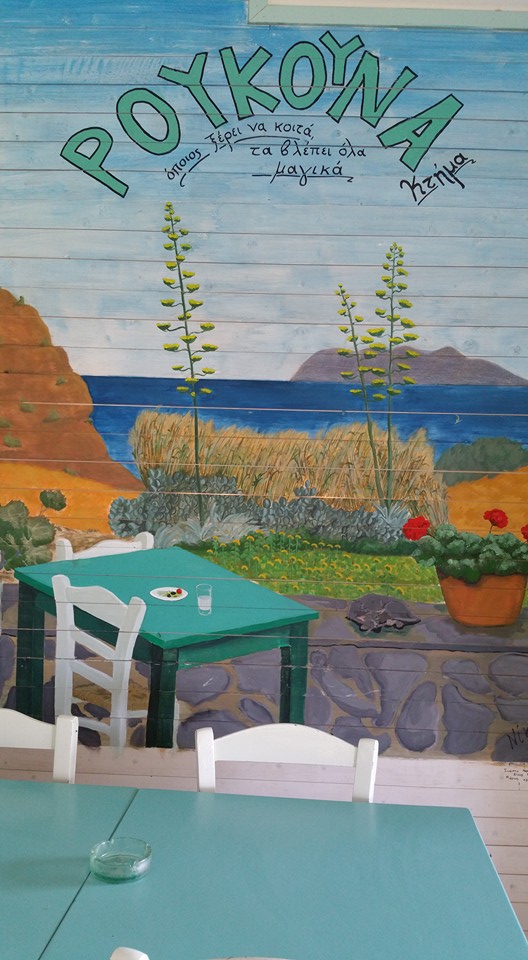 Ktima Roukouna is a beautiful restaurant set back from Roukouna beach and another place I don’t think I’d ever grow tired of. Surrounded by fields that are growing and feeding your lunch, this restaurant quietly wins high-end restaurant manifesto bingo. It’s seasonal and local because that’s what used to happen rather than because someone read the Michelin guide. It’s farm to table in the sense that someone with a strong arm and a good aim could throw the ingredients straight from the field into the kitchen. I’m sure that they have menus but I never saw one, rather I went and chatted to one of the brothers who run the place to hear what was good. On the first day I had a saddle of rabbit in a lemon sauce cooked over potatoes that could well have been called pomme fondant and doubled in price in a different context. The whole plate was a Van Goghesque sunflower swirl of golds and yellows and was simply delicious. The briam was another dish we ordered on every trip. Made with ingredients that we could see growing from our seat, in particular the white augerines that Tassos was quite rightly proud of, it was rich and complex and the kind of dish that satisfies the earthier tastes of a meat eater. My only suggestion, and this is probably a moot point as you will be on holiday, but don’t plan a heavy afternoon after a visit as you might find yourself needing to inspect the insides of your eyelids on the beach not long after finishing.
Ktima Roukouna is a beautiful restaurant set back from Roukouna beach and another place I don’t think I’d ever grow tired of. Surrounded by fields that are growing and feeding your lunch, this restaurant quietly wins high-end restaurant manifesto bingo. It’s seasonal and local because that’s what used to happen rather than because someone read the Michelin guide. It’s farm to table in the sense that someone with a strong arm and a good aim could throw the ingredients straight from the field into the kitchen. I’m sure that they have menus but I never saw one, rather I went and chatted to one of the brothers who run the place to hear what was good. On the first day I had a saddle of rabbit in a lemon sauce cooked over potatoes that could well have been called pomme fondant and doubled in price in a different context. The whole plate was a Van Goghesque sunflower swirl of golds and yellows and was simply delicious. The briam was another dish we ordered on every trip. Made with ingredients that we could see growing from our seat, in particular the white augerines that Tassos was quite rightly proud of, it was rich and complex and the kind of dish that satisfies the earthier tastes of a meat eater. My only suggestion, and this is probably a moot point as you will be on holiday, but don’t plan a heavy afternoon after a visit as you might find yourself needing to inspect the insides of your eyelids on the beach not long after finishing.
To Liotrivi
To Liotrivi is one of, if not the, fish place on the island. It’s run by a fisherman and his three daughters who I was told, were out on the boat with him from the age of four learning the ropes, nets and catch. When not braving the waves they bring their knowledge of fish and seafood, tableside. We had a very illuminating conversation about beetle fish, which I hadn’t heard about and which triggered a shouted cross restaurant, cross generational discussion which I thoroughly enjoyed. We started with various appetisers lead by a stand out tarama. There is a theory that French chefs are asked to make an omelette as part of their interview process because while everyone thinks they can cook one, it surprising easy to get wrong. I wonder if tarama is the Greek equivalent. If so the chef at To Liotrivi is getting the job. We followed this with some spankingly fresh and perfectly cooked sea bream and several plates of the excellent fried potatoes. A delicious bottle of Stefanos’ local wine was the perfect accompaniment. (See below)
Armenaki
Armenaki was the name that kept coming up when I said I was going to Anafi and I immediately saw why on arriving. Set on a high balcony with a breathtaking view, the tables are packed close enough that it gives the impression that everyone is dining together while never felling cramped. A neat trick that many fail to pull off. This celebratory, family-gathering feeling is amplified by the three musicians tucked into a corner playing wonderfully unobtrusive traditional Greek music. The menu is Greek classics with a couple of interesting surprises. The tuna is a must try. Treated more like a steak than fish it comes thickly sliced, on the bone and simply seared and was very good indeed. An excellent wine list with a particular focus on Estate Argyos completes the picture. Armenaki is one of those places that gets it all right while making it look easy, which is harder than it looks.
Bandieroli
This marvelous space in the chora resembles an old ship’s fo’c’sle, not that I’ve ever actually seen one but such is the feeling of the place that one starts to wax lyrical. It’s run by the charming Stefanos, a serious and soulful wine maker, chef and bon vivant. He has his own Ktima Flamourou label producing a range of local wines, some of which are low intervention but all of which are delicious. He also has a surprisingly varied (given the space) selection of some of the more interesting wines being produced in Greece at the moment which he tells me is set to grow. The menu shows a deft hand in the kitchen and some serious technique. We had both crudos that were on the menu the night we went, a red sea bream and an amberjack which were delicate and delicious. The briam with grouper was another stand out with the firmer texture of the fish pairing perfectly with the rich and earthy flavours of the briam. Get down there and help Stefanos free up some space in his cellar for all the new wine he wants to buy.
Where we stayed
We stayed at a boutique hotel set back on a hill side about ten minutes from the port called Ypseli. Ypseli is the Aegean word for the hives which you will see dotted around the island and the sense of quiet and calm industriousness fits the place well. In keeping with the general feeling on the island the emphasis here is about creating a peaceful place where you can relax and unwind. The garden with flowers and herbs rustles soothingly in the wind and the quietly attentive staff are on hand with another juice, tea or cocktail. On the cocktail front, I need to make special mention of the Maistros. This is a twist on a daiquiri which is one of the great cocktails that has been much abused over the years (frozen strawberry daiquiri anyone…) It was a revelation and I have spent a fair bit of time trying to replicate it at home. I think I need a few more research trips. The multi-course breakfast is another highpoint of the stay. Eaten on a terrace with uninterrupted views of the Anafi’s sibling islands, the menu is full of delicious and nourishing local produce and is a wonderful way to start a day. The rooms are comfortable, clear and well-appointed. Everything you need to unwind, relax and recharge.
What we saw
Arsenale
Arsenale is a library, bookshop, art space and meeting place and more, that opened recently in an old boat shed on the port. It is the brainchild of three close friends with long ties to the island, Theodore Psychoyos, George Divanis and Kaptan Nikolas. A great example of the creative process, the idea came about slowly, then all at once, as the “boys” as they are affectionately referred to, had long wanted to collaborate and settled on a library based on memories of long lazy summers spent reading classics on the beaches. The space has thoughtful selections from some of the more interesting libraries, book clubs and publishers around the Med, including The Hydra Book Club, Hyper Hypo, Nomas and many more. There is a carefully curated selection of objects from artists and craftspeople with works by Diane Alexandre, Camille Cornillon, and Christianna Economou amongst others. A commanding sculptural table by Theodore, whose primary job is as one of Greece’s leading artists working in marble, fills the space and is made from marble that has been sourced for many of the same countries as the book selections. The thought, knowledge and expertise that has gone into creating the space mean that regardless of what you buy, it is a mentally and emotionally nourishing place to be.
Phenomenon
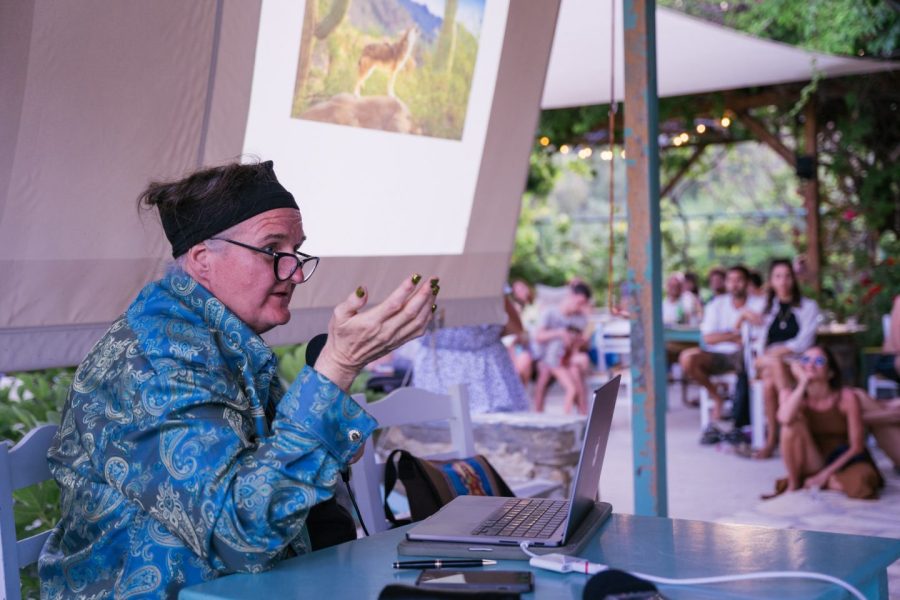
Alexandra Masmanidi – Phenomenon
Although at the time of writing, Phenomenon, the biennial project for contemporary art housed on, and inextricably linked to, the island of Anafi has been and gone, it is worth mentioning because it also captures the sense of creative exploration that flourishes everywhere. Conceived by partners in art collecting and life, Iordanis Kerenidis and Piergiorgio Pepe in 2014. It seeks to challenge the normative role of art collecting as purchasing and accumulating. They wanted to enable the creative process more closely and provide space, both figuratively and literally, for artists to explore themes and topics that they jointly found rewarding and urgent. This year’s theme is returning, or to use the Phenomenon formulation, “re-turning” which touches on the millennia of exodus, occupation, and reclamation both the island, and Greece as a whole has experienced. This year’s project featured a room sized camera obscura created by Zoe Leonard as well as an entirely new shape of bread inspired by the Tholos that dot the island. A unique and important initiative.
Leaving Anafi
The last day was as dislocating, weird and wonderful as the first. As Anafi is the end point for the ferry route, it leaves as well as arrives at 5am. We had a last drink at Florans Café where Martha and Giannis were a constant and most welcome presence during our many trips to the port. Giannis was very patient with me as I wanted to try a cocktail of ouzo and coke that I had been told was increasingly popular. Having tried it, I’m not sure why. And then we managed to fit in a last meal at Nektaria’s restaurant Akrogiali on the port. Thankfully friends of ours had the foresight to book ahead for the famous lobster pasta so, in keeping with the Anafi way, we joined them and enjoyed. It was clear while waiting on the port that people had opted for one of two approaches to leaving; stay up and get straight on or have a couple of hours of bleary sleep. It wasn’t immediately obvious which approach was better although some of the bodies slumped over tables on the deck later argued for the latter. What was clear was that no one was judging either approach which sums up the feeling of quiet tolerance and mutual respect that suffices the island. I’m already planning my return, or re-turn.

